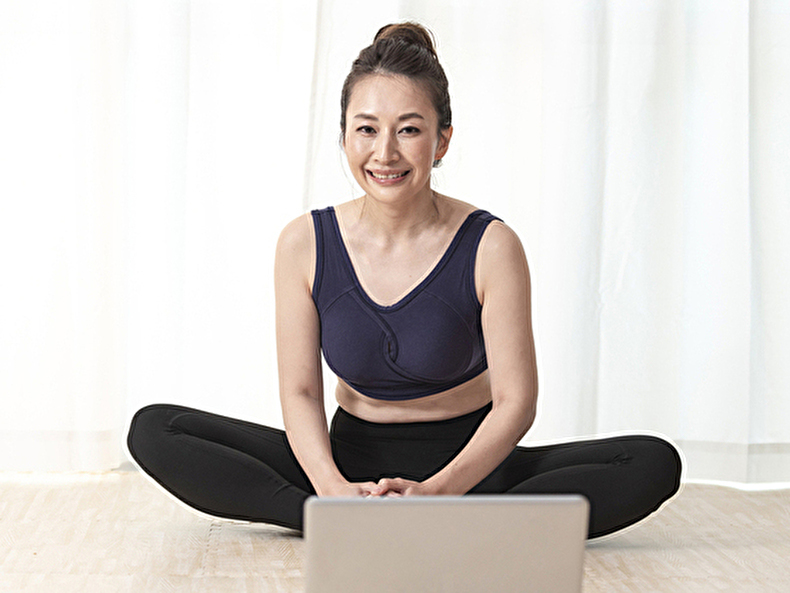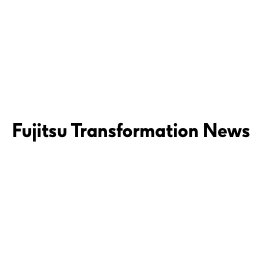Fujitsu developed the Judging Support System in collaboration with the International Gymnastics Federation. The technology used in this system digitalizes the movements of the human skeleton and uses AI to calculate a performance score. Leveraging this technology, we created the Core Assessment App to improve the health and well-being of the general public. We also had the opportunity to have the public try out our app at the FIG Artistic Gymnastics World Championships which were recently held in Kitakyushu.
- Contents
-
- Using AI Judging Technology To Improve People’s Health
- We Developed the “Core Assessment App” To Give Users Individualized Feedback About Their Bodies and Conducted a Demonstration With the Help of the Gymnastics World
- Making Health Fun: Contributing to Well-Being Through a Body Movement Digitalization Platform
Using AI Judging Technology To Improve People’s Health
Fujitsu created the Judging Support System in collaboration with the International Gymnastics Federation and put it into use in 2019 (Click here for a detailed article). We initially developed this system to improve the objectivity and fairness of scoring in gymnastics competitions. However, as we continued discussions with the International Gymnastics Federation and others involved in gymnastics, some of our partners started thinking about using this technology to review performance and teach techniques that are safer for athletes' bodies. This could help address the increasing number of injuries and the shortening of athletes' careers caused by the increasingly sophisticated moves within gymnastics.
Furthermore, the philosophy of Morinari Watanabe, president of the International Gymnastics Federation, is to “bring happiness to people by extending their health span through gymnastics.” Watanabe’s philosophy resonated with us here at Fujitsu and we began to look for ways to use our technology that digitizes and evaluates human body movements to improve the well-being of the public, with a focus on preventing injuries, promoting recovery, and addressing lack of exercise.
In particular, we focused on mitigating the secondary health effects of the COVID-19 pandemic. As people continue to stay at home, issues associated with this sedentary lifestyle, such as shoulder and lower back pain associated with working from home and physical inactivity with aging, have become increasingly apparent. Online fitness classes have become a popular solution, but most of these are one-sided; the instructor only models the movements and users do not get feedback. So, we wondered if we could use our technology that digitizes human body movements to measure the difference between an ideal model and an individual user's posture and movements. This would allow us to provide constructive, customized feedback to participants.
We Developed the “Core Assessment App” To Give Users Individualized Feedback About Their Bodies and Conducted a Demonstration With the Help of the Gymnastics World
The first stage of our project was based on the findings of sports science research conducted by Professor Koji Kaneoka of the School of Sport Sciences at Waseda University. We developed a Core Assessment App in which AI evaluates core flexibility and range of motion based on pictures of five poses taken with a webcam and based on this evaluation suggests individually tailored exercises for improvement.
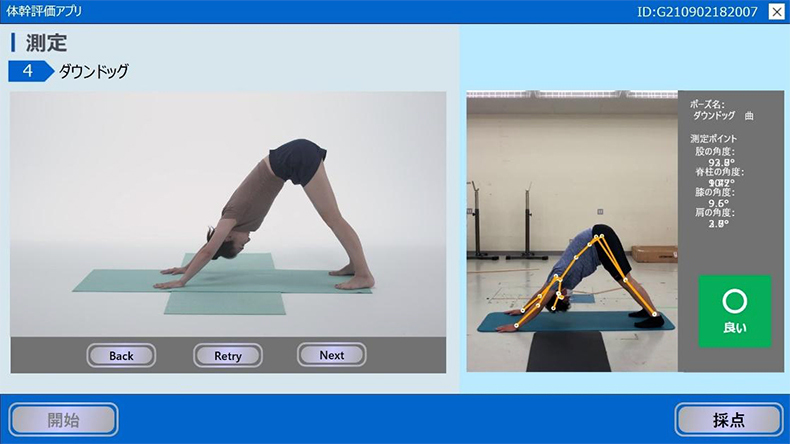 Measurement screen: (Left) Pose guidance (Right) User's image of the pose and measurement results
Measurement screen: (Left) Pose guidance (Right) User's image of the pose and measurement results
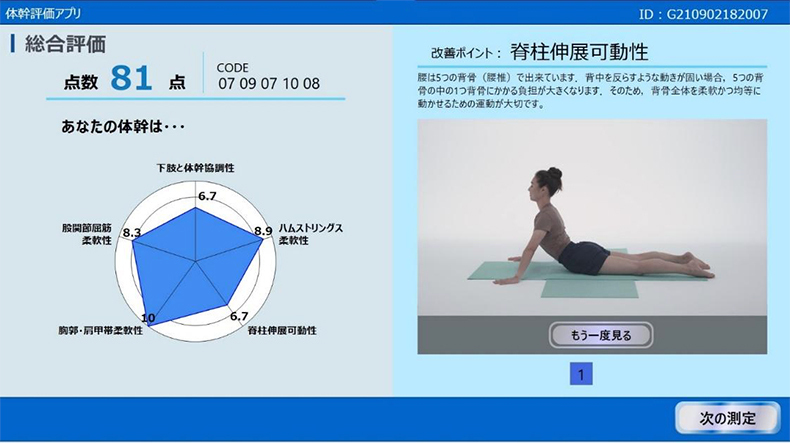 Evaluation and exercises for improvement screen: (Left) Comprehensive evaluation after photographing all poses (Right) Advice and an exercise video for improvement based on the comprehensive evaluation
Evaluation and exercises for improvement screen: (Left) Comprehensive evaluation after photographing all poses (Right) Advice and an exercise video for improvement based on the comprehensive evaluation
Then, we had visitors try out the system at Sante Gym*, which was held concurrently with the 2021 FIG Artistic Gymnastics World Championships in Kitakyushu in October 2021.
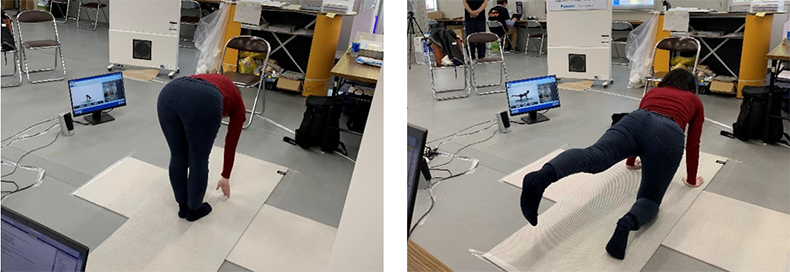 * Demonstration at Sante Gym, a health promotion event for seniors.
* Demonstration at Sante Gym, a health promotion event for seniors.
Sante Gym was held at a large shopping mall in Fukuoka Prefecture. In total, approximately 700 people from diverse backgrounds, such as general visitors, doctors from the medical team involved with the competition, and ambassadors from the International Gymnastics Federation, tried our app. They all did the same poses in front of the app and walked away with individualized advice and exercises for improvement.
We received positive feedback from the participants such as, “I now know my weaknesses and it was helpful” and “I found out that I'm actually not able to do things I thought I was doing correctly,” but the most common comment we received was that it was fun. We learned that the simplicity of our app, with its five easy poses, scored out of 100 points, and its suggestion of only one exercise made it a fun and casual experience. This led participants to comment that it was fun to use. Exercise is supposed to be fun, and the best way to continue exercising is to enjoy doing it. That is the key to achieving good health through exercise. Through our real-world demonstration, we realized anew that the goal of our app should be to help people enjoy exercising.
Making Health Fun: Contributing to Well-Being Through a Body Movement Digitalization Platform
In order to connect the feedback we received from participants with improved health and well-being, we would like to provide a service that can be easily continued at home or at a nearby health facility. To this end, we aim to expand the capabilities of this technology so that it can be used to evaluate a range of other body movements, and ultimately plan to commercialize it as a “body movement platform.” As an example, an orthopedic surgeon that tried our app at Sante Gym commented “I would love to work with you when you develop a method for the knee,” and another medical provider has consulted with us about implementing our technology in their hospital and medical fitness center, saying that the technology shows potential for application in medicine and rehabilitation. Furthermore, this technology can be combined with exercise methods such as dance and strength training to create new fitness services. We would like to proactively partner with individuals and companies that have their own exercise methods, as well as with app developers, to explore these exciting possibilities.
Fujitsu has established seven Key Focus Areas and has announced that we will focus our research and development resources in five technological areas, including AI, to support these Key Focus Areas. Fujitsu has strengths in these five technological areas and these areas are crucial for transforming business and realizing a sustainable society through digital innovation.
We hope to apply our body movement digitalization technology in many fields to make it useful to society and support the well-being of people everywhere.
Related Articles
- “AI Judging at Sports Competitions” Opens the Way for a Healthy Future
- [Press Release] Fujitsu AI Technology Recommends Exercises Customized to Users’ Needs in New Trial
- [Press Release] Fujitsu’s AI-Powered Gymnastics Scoring System Wins the Judge’s Award at the MM Research Institute Award 2021, Smart Solutions Category
- [Solutions Website] Fujitsu's ICT in Artistic Gymnastics: Judging Support System
- 2021 Fujitsu R&D Strategy Briefing (12 October, 2021)


